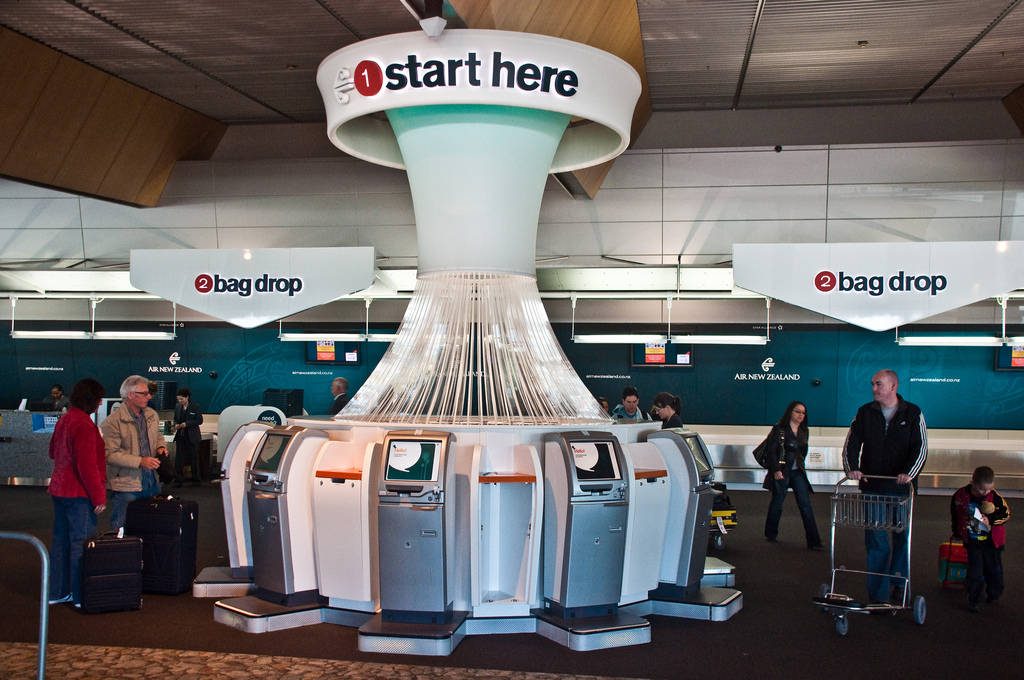[Photograph - Air New Zealand self check-in centre by Phillip Capper under Creative Commons]
“Alone we can do so little; together we can do so much” – Helen Keller
Let me ask you an oxymoronic question: How can companies increase customer satisfaction by cutting cost?
The problem, though perplexing, has been resolved. The corporate world has arrived at a solution that is simple, effective, elegant and cost-effective.
The irony is customers, unknowingly, are an integral part of the solution.
To increase customer satisfaction, corporates are “hiring” customers themselves as partial employees. Once customers become partial employees, complaining about bad service is tantamount to complaining against themselves.
Take McDonald’s. You stand in a queue to place your order, pay for it, collect the food on a tray, walk back to your seat, consume it and deposit the waste in the bin. So, were you only a customer at McDonald’s? No, you were a partial employee. You did things that should ideally have been done by employees hired and paid for by McDonald’s.
But did McDonald’s pay you for the services you performed for it? Of course not.
Watch a video of this episode or continue reading
Episode 24: New Rules of Business
Now, with the omnipresence of the internet and smart devices, many more industries have embraced the concept of turning their customers into partial employees.
Take airlines. Till recently, a flier would have had to visit the office of a ticket agent, who would understand the requirement, draw up an itinerary, book the tickets, issue them and collect payment. The airline would have to pay commission to the agent for providing these services, an expense that would chip away at its bottom line.
The airlines had to invest in creating infrastructure at the airport so that the queues would be small. They had to plan for adequate space to set up kiosks, keep an inventory of blank bording passes to print and issue, and man the kiosks with trained employees. All this resulted in further expenses which too chipped away at their bottom line.
Not anymore.
Today, a flier, now rechristened “guest”, visits the internet to
- Research flight availability
- Decide on the airline and flight
- Book tickets and make online payment
- Print the tickets
- Go online before the journey to select seats
- Check themselves in, print boarding passes and head straight for security check
Now, airlines do not have to pay commission to ticket agents, or have a large number of employees to manage check-in counters. Guests who have “skirted their duty” of checking themselves in are offered one more chance to redeem themselves at the airport. There are terminals for self check-in where guests can print out boarding passes for themselves. These jobs have been “outsourced” to the guests without paying them a dime.
More importantly, there’s little chance of a drop in “guest” satisfaction levels. If anything, the satisfaction levels increase because guests cannot complain against any lapse in service because they are in charge of providing it to themselves.
The guests have become partial employees of airlines, doing part of the job that was earlier being done by airline employees. Result: savings for airlines and increased guest satisfaction.
The job of the brand owner now is to provide an obstacle-free, easy-to-navigate and secure platform on which the partial employees can “work”.
For an airline, the platform is its website. It should be easy to navigate, entail simple steps for taking crucial decisions and provide safe, secure and multiple payment gateway options.
By providing a conducive “work” environment to the partial employees, the brand owners have transferred the onus for getting a good experience to the partial employees.
For instance, a customer seeking to block her preferred seat on a flight finds it has already been taken. As a partial employee, she will blame herself for not blocking the seat earlier. In pre-website days, if the customer came to the check-in counter and found her preferred seat unavailable, she was likely to blame the airline.
Several other industries have not only embraced this trend, but have gone a step further. Instead of converting a customer into merely a partial employee, they are converting them into full-time employees.
Take courier companies. They have assigned a major chunk of their operations to their customers, converting them into full-time employees. Without paying them a penny, of course. As a full-time employee, a customer has to carry the parcel to the courier company’s office, fill in the delivery details on the system provided to them, pay the courier charges, print the receipt and deposit the parcel at the desingated location. Then she has to herself track the progress of the parcel till it reaches its destination.
Banks too have warmed up to the concept and are pushing the envelope even further. Not only do they aspire to make every customer a full-time employee, but also penalize them if they do not carry out the new responsibilities in a manner profitable to the bank. For instance, modern-day banks dissuade customers from visiting the branch or using cheque leaves to transact business. If their customers indulge in either practice, it means expenses for the bank, which would chip away at their bottom line.
Take cheque leaves. Banks expect their “full-time employees” to carry out transactions using internet banking, not cheques. Of course, a minimum number of cheque leaves are issued every quarter; if more are ordered, customers are charged.
Laying the runway for this phenomenon are certain irrevocable trends:
People today are time-poor. Hence, they detest wasting their time waiting at branches or standing in queues.
People wish to have peace of mind and hence desire control over their activities.
The deep penetration of the internet, large-scale adaptation of smart devices and the enthusiasm for technology has given young adults the tools to become willing employees. And they relish the “control” that this provides.
You too can convert your customers into partial a full-time employees. For that you will have to provide an obstacle-free, easy-to-navigate and secure platform on which they can “work”. This can be achieved by embedding “SMAAC” technology platform into your business model.
SMAAC stands for:
S = Social
M = Mobility
A = Apps
A = Analytics
C = Cloud
No wonder more and more companies are attempting to engage their customers as partial or full-time employees—and see customer satisfaction soar even as costs plummet.
Sometimes, an oxymoron fails to live up to its name.
Key Takeaways:
- Involving customers in performing tasks is likely to reduce operational costs for companies.
- It will also stop customers from complaining about poor services.
- A company should provide an excellent technology platform based on SMAAC, through which customers can engage with the company.
[This is the concluding episode of Season 1 of New Rules of Business. Rajesh Srivastava will be back after a small break with a whole new set for Season 2. If you have any questions or feedback, mail us at askrajesh@foundingfuel.com]


